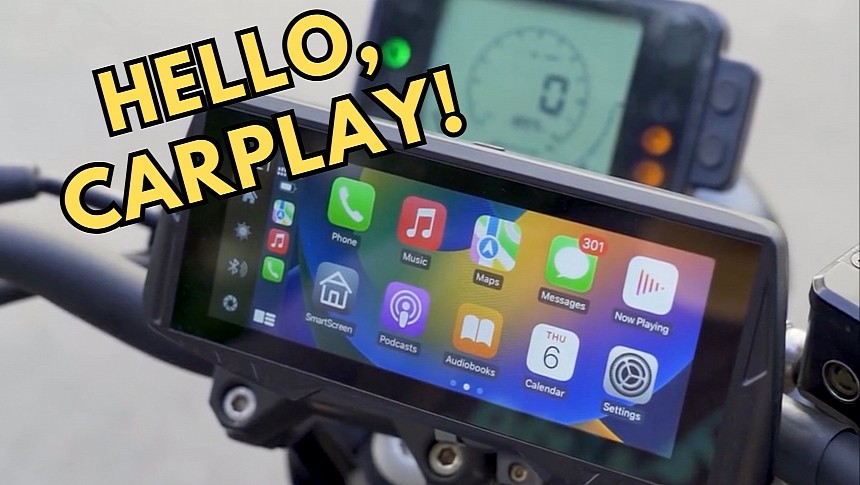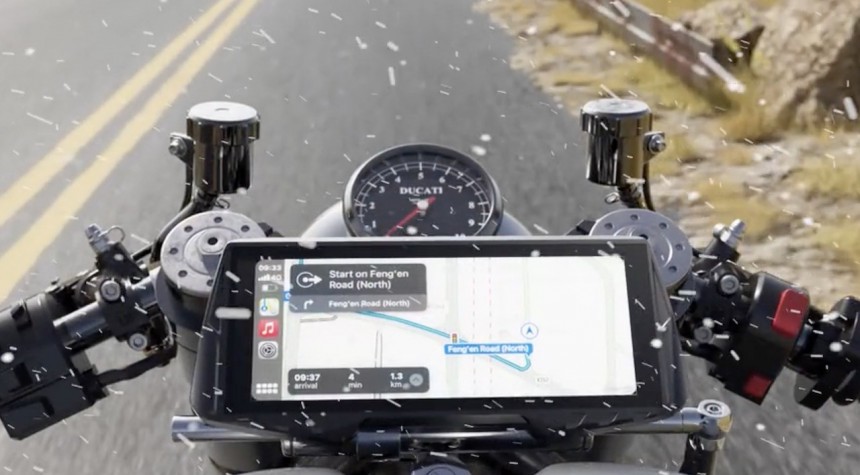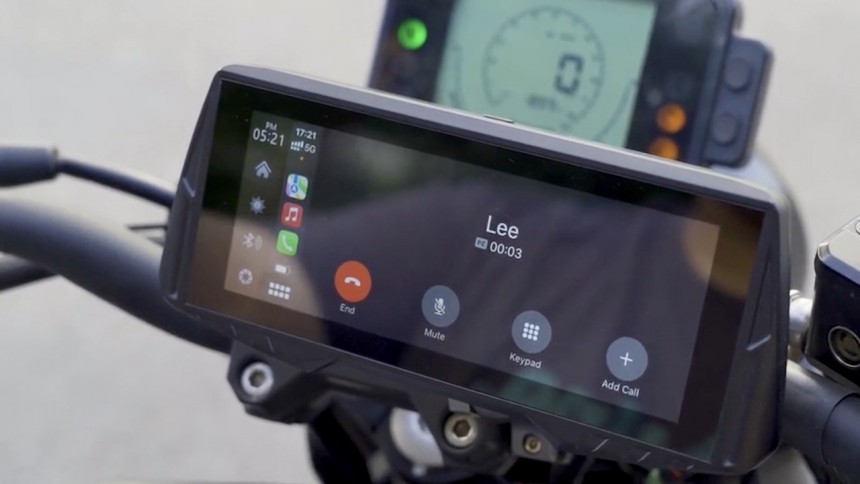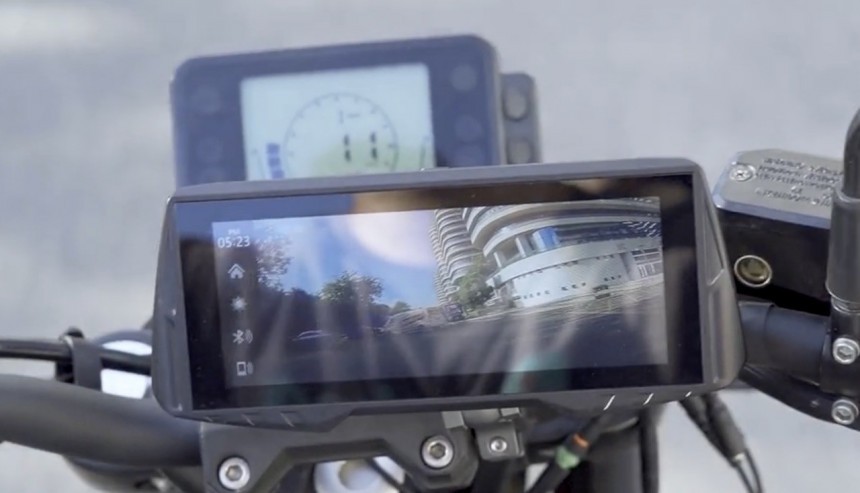Android Auto and CarPlay have become must-have equipment in new cars, and Apple's figures confirm that the adoption of mobile phone projection systems is on the rise. Nearly eight in ten new-car buyers in the United States want CarPlay and are ready to cancel their order if they don't get the feature.
Carmakers noticed the growing demand for Android Auto and CarPlay, so the two systems are now available as standard, either wired or with wireless support.
Motorcycle manufacturers also align with the new market trends, adding CarPlay and Android Auto to their latest models. On the other hand, retrofitting an older bike with these systems is often quite a challenge, both from an installation perspective (as universal units are pretty rare) and as far as pricing is concerned.
A company called NaviCam has come up with a new product that should fit any motorcycle model worldwide.
Their device is called Navicam and is a mini-computer with a 6.86-inch screen capable of running Android Auto and CarPlay. The parent company says the device runs Linux, but I believe it's actually Android with integrated support for mobile phone projection (Android is technically Linux, so the company isn't wrong).
The device comes with a mounting kit that includes a lightweight aluminum alloy bracket. The company says Navicam securely stays in place, so you don't have to worry about the screen falling to the ground in the middle of the ride.
Navicam includes all the bells and whistles of a modern portable computer, including Bluetooth and Wi-Fi to connect to your phone and other accessories. You can use a headset to talk on the phone and listen to voice guidance in Google Maps by connecting via Bluetooth to the device.
The 6.86-inch LCD screen has a resolution of 1280x480 pixels and features a maximum brightness level of 1,000 nits. In theory, you should be able to see what's on the screen even in direct sunlight.
The device also integrates additional ports for a microSD card and front and rear cameras. You can record what happens on the road and store the recording on the card. Tire pressure monitoring is also available with an optional transmitter.
As anyone can guess, the biggest challenge for such a device is to withstand the changing weather conditions. Navicam sports an IP65 rating, which means it should withstand dust and a water splash, though you're not supposed to submerge it into water. In other words, you should be fine if you ride your bike in heavy rain, but you'd better not do this for several other reasons that have nothing to do with Navicam.
The company explains that the device's durability was a main concern during the design phase, so Navicam sports a special sunscreen ink layer for extra protection. In theory, this extra layer prevents the rain from accumulating on the screen, but the developing team says it also helps increase the service life, making it more durable in the long term.
The device has already been tested at extreme temperatures, and the parent company says it should withstand up to 70 degrees Celsius. The plastic parts are OK even in 100 degrees Celsius temperatures. The design was specifically created to allow for efficient heat dissipation. Navicam comes with a metal heat sink on the bottom for this purpose.
Android Auto and CarPlay can be used wirelessly, so you just pair the devices and then keep the smartphone in the pocket or the backpack. The interface should load automatically, and you can then interact with Android Auto and CarPlay using touch and voice.
Navicam gets its power from a 12V supply, so the first version has no USB power support. If you're interested in anti-theft systems, you might be a little disappointed, as you'll have to remove the screws every time you park the bike. Fortunately, the device comes with quick-release wires for the bracket and the main unit, so the screws are the only problem.
The parent company promises to ship updates frequently, but wireless updates are not yet available. As a result, the only method to install new firmware is to download it from the Navicam website, copy all files to the microSD card, and then insert it into the device. It's the old-school system that we've used for vintage GPS navigators, and while it feels outdated, at least it serves the purpose very well.
Navicam was recently posted on Kickstarter, seeking crowdfunding support to enter mass production. The device reached the funding goal very fast, so it's just a matter of time until the parent company starts shipping the first units. It should happen in November.
If you want to buy the device, you can do it via the Kickstarter page. The Super Early Bird package is available for $269, with the price expected to increase to $399 when the promo expires.
Motorcycle manufacturers also align with the new market trends, adding CarPlay and Android Auto to their latest models. On the other hand, retrofitting an older bike with these systems is often quite a challenge, both from an installation perspective (as universal units are pretty rare) and as far as pricing is concerned.
A company called NaviCam has come up with a new product that should fit any motorcycle model worldwide.
Their device is called Navicam and is a mini-computer with a 6.86-inch screen capable of running Android Auto and CarPlay. The parent company says the device runs Linux, but I believe it's actually Android with integrated support for mobile phone projection (Android is technically Linux, so the company isn't wrong).
The device comes with a mounting kit that includes a lightweight aluminum alloy bracket. The company says Navicam securely stays in place, so you don't have to worry about the screen falling to the ground in the middle of the ride.
The 6.86-inch LCD screen has a resolution of 1280x480 pixels and features a maximum brightness level of 1,000 nits. In theory, you should be able to see what's on the screen even in direct sunlight.
The device also integrates additional ports for a microSD card and front and rear cameras. You can record what happens on the road and store the recording on the card. Tire pressure monitoring is also available with an optional transmitter.
As anyone can guess, the biggest challenge for such a device is to withstand the changing weather conditions. Navicam sports an IP65 rating, which means it should withstand dust and a water splash, though you're not supposed to submerge it into water. In other words, you should be fine if you ride your bike in heavy rain, but you'd better not do this for several other reasons that have nothing to do with Navicam.
The company explains that the device's durability was a main concern during the design phase, so Navicam sports a special sunscreen ink layer for extra protection. In theory, this extra layer prevents the rain from accumulating on the screen, but the developing team says it also helps increase the service life, making it more durable in the long term.
Android Auto and CarPlay can be used wirelessly, so you just pair the devices and then keep the smartphone in the pocket or the backpack. The interface should load automatically, and you can then interact with Android Auto and CarPlay using touch and voice.
Navicam gets its power from a 12V supply, so the first version has no USB power support. If you're interested in anti-theft systems, you might be a little disappointed, as you'll have to remove the screws every time you park the bike. Fortunately, the device comes with quick-release wires for the bracket and the main unit, so the screws are the only problem.
Navicam was recently posted on Kickstarter, seeking crowdfunding support to enter mass production. The device reached the funding goal very fast, so it's just a matter of time until the parent company starts shipping the first units. It should happen in November.
If you want to buy the device, you can do it via the Kickstarter page. The Super Early Bird package is available for $269, with the price expected to increase to $399 when the promo expires.













